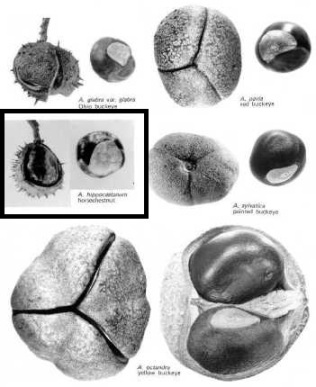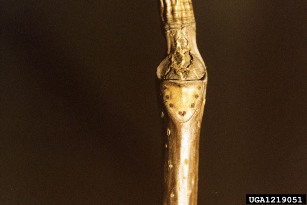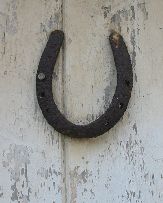
 Horse Chestnut
Horse Chestnut
WELCOME! If you have a strong passion for learning about
incredibly interesting organisms you have come to the right
place. This website is dedicated to the Horse Chestnut tree, or
Aesculus hippocastanm. The prefix hippo-
appropriately translates from the Greek to mean "horse."
The reason this tree is named after the horse is a topic of
debate, but a common explanation is shown in the cover photo
above. The
leaf scar on the Horse Chestnut tree very
closely resembles a horseshoe. The end of the species
name, -castanum , is a reference to its close
resemblance to true chestnut trees, members of the genus
Castanea. Despite its mistaken identity as a chestnut
tree, it strictly does belong with the other members of the
Aesculus genus. See
Classification for more information on the Aesculus
genus.
 The horse chestnut originated from the Balkan peninsula, but has
since spread throughout the Northern Hemisphere and has
proven to become quite important in these new environments. These trees provide a unique habitat/host for other organisms,
health remedies, lumber, beautiful ornamentation along streets
and in parks, and even "conkers" for enjoyment.
However, the horse chestnut tree can be lethal. Throughout
the tree, but especially in the seeds, there is a toxin called
aesculin that can cause vomiting, nausea, enlarged pupils,
paralysis, diarrhea, muscle weakness and twitching, kidney
problems, coma, and even fatality if enough is ingested.
For more on this toxin see
Health & Horse Chestnuts.
The horse chestnut originated from the Balkan peninsula, but has
since spread throughout the Northern Hemisphere and has
proven to become quite important in these new environments. These trees provide a unique habitat/host for other organisms,
health remedies, lumber, beautiful ornamentation along streets
and in parks, and even "conkers" for enjoyment.
However, the horse chestnut tree can be lethal. Throughout
the tree, but especially in the seeds, there is a toxin called
aesculin that can cause vomiting, nausea, enlarged pupils,
paralysis, diarrhea, muscle weakness and twitching, kidney
problems, coma, and even fatality if enough is ingested.
For more on this toxin see
Health & Horse Chestnuts.
The horse chestnut has also occasionally received fame. It
was, in fact, a horse
chestnut tree which provided shelter for Anne Frank as she hid
from the Nazi regime all those years ago. Throughout her diary she often
marveled at the majestic tree which is now reaching its end.
However, it has become such an important beacon of hope and
purity that saplings from this 150 year old tree are being
planted at Little Rock Central High, a sight of painful forced
school integration in 1957. See
Interactions
for more information on Anne Frank's horse chestnut tree.

These are absolutely awe-inspiring and beautiful trees.
They usually reach to about12 meters
(approx. 40 feet) in height and about 8 meters (approx. 26 feet)
wide. In May the horse chestnut produces clusters of white
flowers with yellow and red spots and in late August/early
September the trees drop their ripened fruits. These
fruits are 1-3 inch spiny spheres containing one to three hard
brown seeds, each with a pale scar. It would seem that
these characteristics would make the Aesculus hippocastanum
easy to identify, but it is often confused with other
members of the Aesculus genus and the American chestnut
tree. The spiky fruit is common throughout this group and
only minute differences are distinguishable from the exterior or
the fruit. Pictured on the left is a number of seeds from
different trees that are commonly confused with the horse
chestnut tree. For more on the reproduction of the horse
chestnut see
Reproduction.
To visit more websites on interesting websites please visit
MultipleOrganisms.net!
Also! Visit our
university website to learn more about this wonderful
university!

